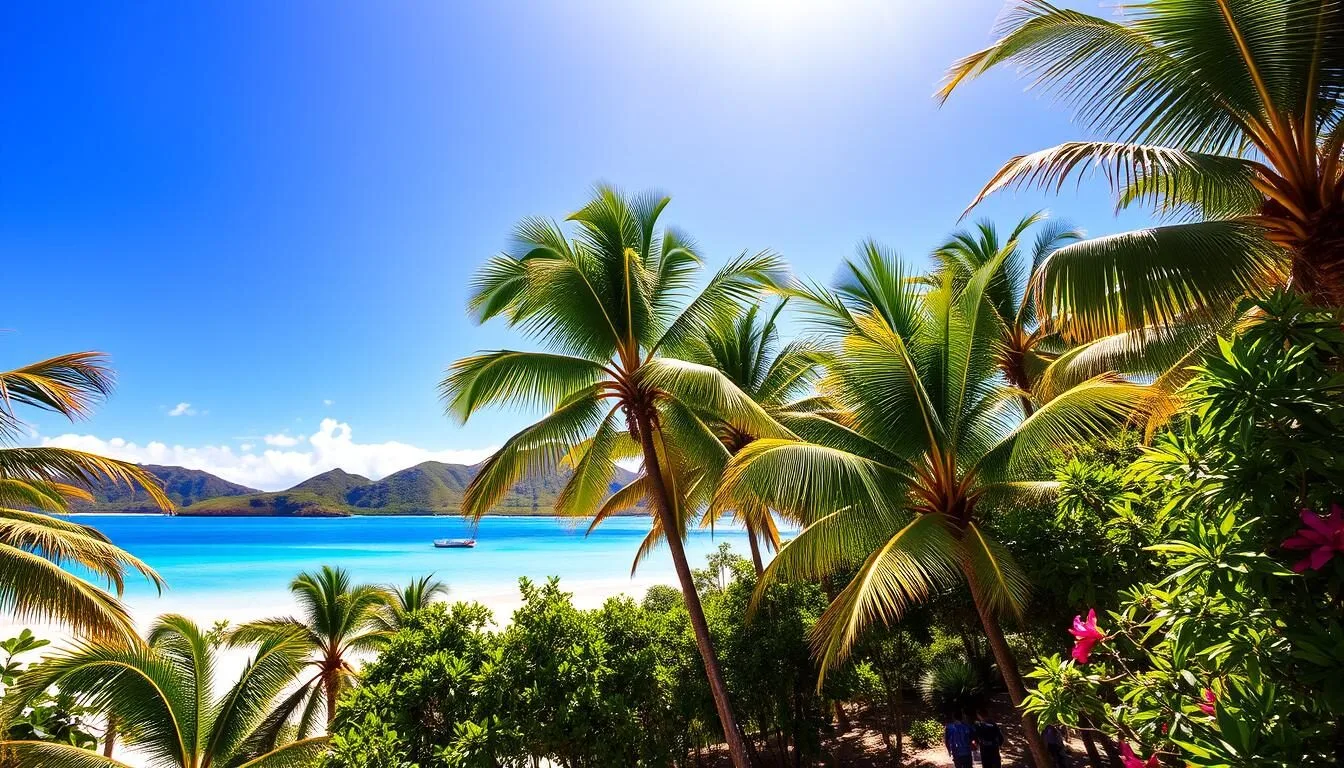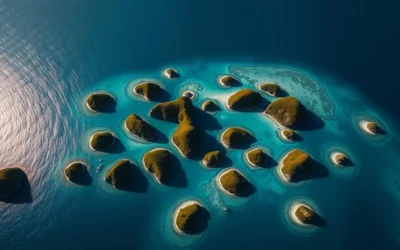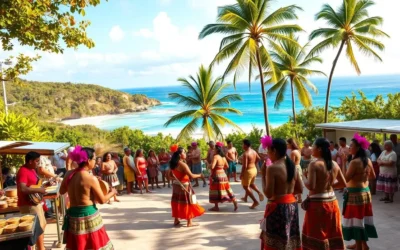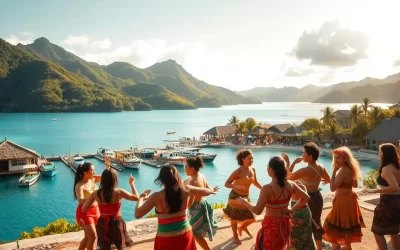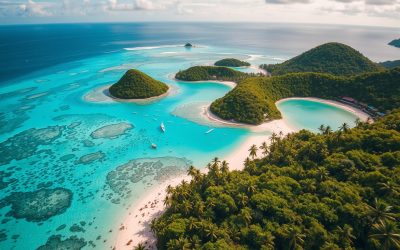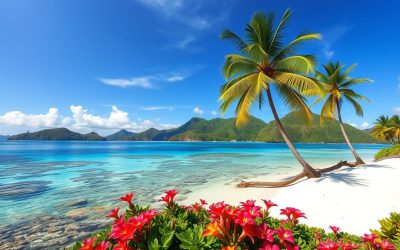✓ Accommodations ✓ Flights ✓ Rental Cars ✓ Tours & Activities
Did you know that Palau’s tropical climate is characterized by hot, oppressive, windy, and overcast weather year-round? With temperatures ranging from 80°F to 86°F, understanding the seasonal variations is crucial for a memorable trip.
You’re planning to visit this Pacific paradise, and you’re eager to make the most of your experience. The good news is that the period from January to April is generally considered the prime window for visiting, with clearer skies and less rainfall.
To ensure a weather-savvy trip, it’s essential to understand the tropical climate patterns and plan accordingly. This will help you enjoy the various activities that Palau has to offer, from world-class diving to cultural explorations.
Understanding Palau’s Tropical Climate
Understanding Palau’s climate requires a look at its geographical location. Palau is situated in the Pacific Ocean, and its tropical climate is shaped by its proximity to the equator.
Geographic Location and Its Impact on Weather
Palau’s geographic location significantly influences its weather patterns. Being an island nation in the Pacific, it experiences a tropical climate with high temperatures and high humidity levels throughout the year. The surrounding waters play a crucial role in maintaining the relatively stable climate.
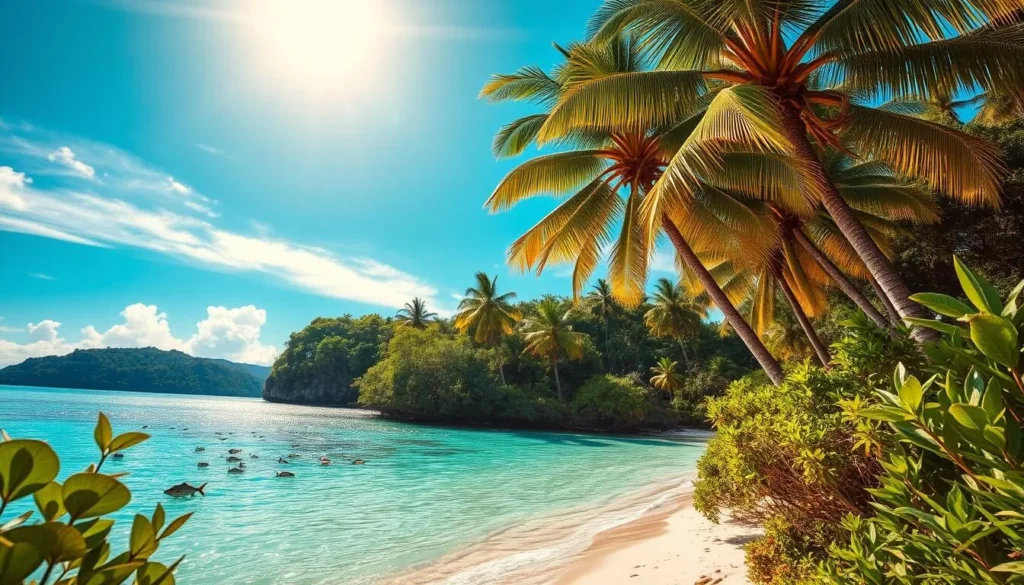
Year-Round Temperature Patterns
The temperatures in Palau remain relatively consistent throughout the year. Daily highs typically range between 80°F and 86°F, while nighttime temperatures rarely drop below 75°F. The water temperatures are also warm, ranging from 82-84°F (28-29°C), making it ideal for swimming and water activities.
| Temperature Range | Daytime Highs | Nighttime Lows | Water Temperature |
|---|---|---|---|
| Typical Range | 80-86°F | Above 75°F | 82-84°F |
The relatively stable climate means you can pack light, breathable clothing for your trip. However, it’s essential to consider rain protection, which varies by season.
The Two Major Seasons in Palau
Understanding the two distinct seasons in Palau is crucial for planning a weather-savvy trip. Palau’s tropical climate is characterized by two major seasons that influence the travel experience.
Dry Season: December to April
While Palau doesn’t have a truly dry season, the period between December and April sees a relative decrease in the frequency of showers and thunderstorms, making it a preferable time to visit. February to April are particularly calmer months.
| Month | Rainfall | Sunshine Hours |
|---|---|---|
| December | Moderate | 7-8 hours |
| January | Moderate | 8 hours |
| February | Low | 8-9 hours |
Wet Season: May to November
The wet season in Palau, spanning from May to November, is marked by increased rainfall, with the heaviest precipitation typically occurring between July and October. Despite the rain, the wet season brings lush, vibrant landscapes to the islands as vegetation thrives with the increased moisture.
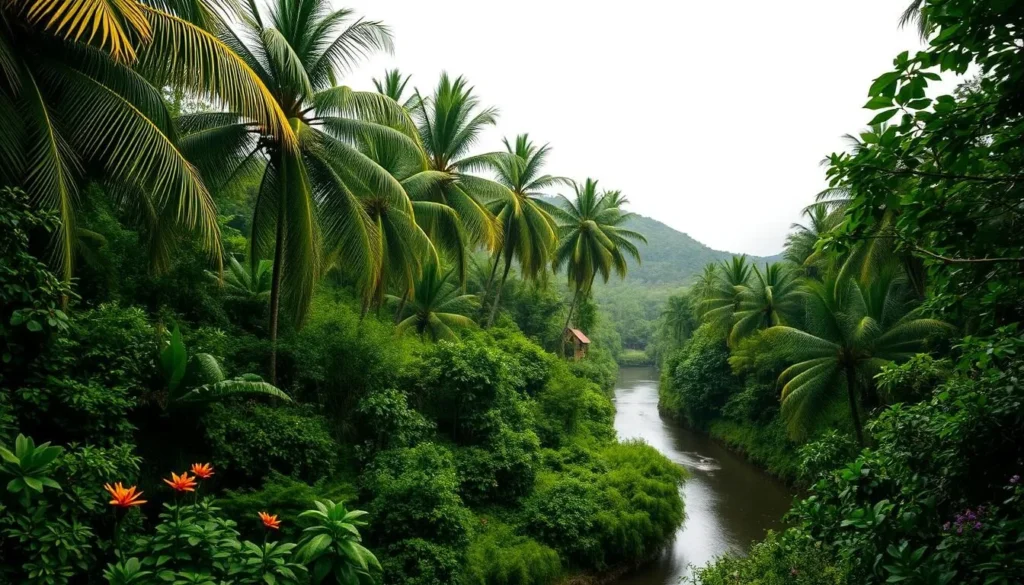
Many water-based activities remain accessible during this time, though it’s advisable to build flexibility into your itinerary. The wet season also means fewer tourists, potentially offering more solitude at popular sites and better rates on accommodations, making it a good time for those who prefer fewer crowds and enjoy activities without the peak season hustle.
Palau: Best Months for a Weather-Savvy Trip
To make the most of your Palau visit, consider the best months for a weather-savvy trip. Understanding the seasonal variations can help you plan a more enjoyable and stress-free vacation.
January to April: The Prime Visiting Window
This period is considered the dry season, offering the most favorable weather conditions for outdoor activities. With minimal rainfall, you can fully enjoy Palau’s renowned attractions without the hindrance of wet showers. It’s the peak tourist period, so expect more crowds, but the conditions are ideal for a trip to remember.
Shoulder Seasons: May-June and November-December
The shoulder seasons offer a compelling compromise between weather conditions and tourist crowds. During these transitional periods, you’ll experience gradually changing rainfall patterns. May and June see increasing rain, while November and December bring improving conditions as they move toward the drier season. These months provide good value for your trip, with lower accommodation rates and many days suitable for key activities. You’ll need to be flexible with your daily plans, as afternoon showers become more common.
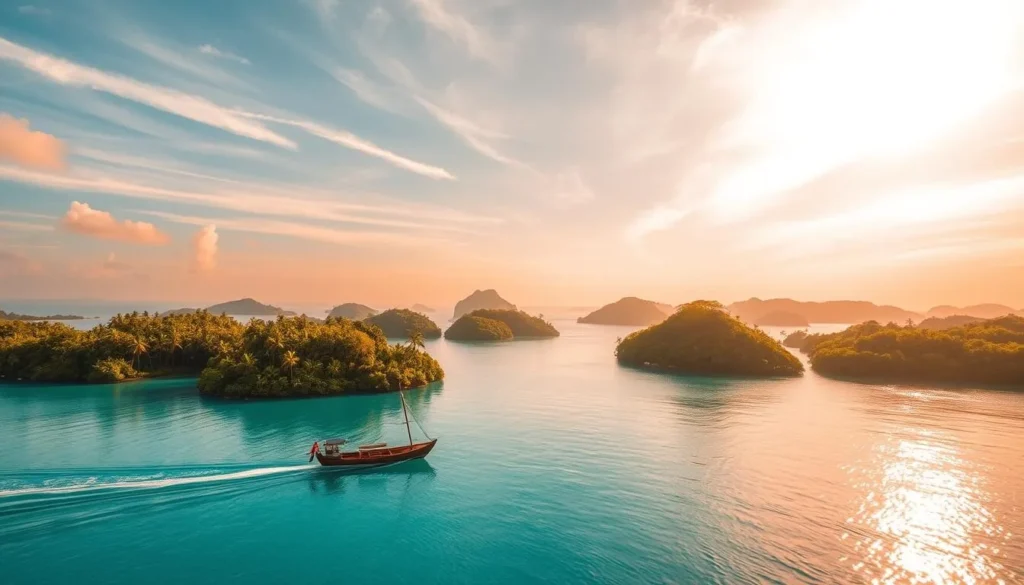
Rainfall Patterns Throughout the Year
Understanding the rainfall patterns in Palau is crucial for planning a weather-savvy trip. The island’s tropical climate is marked by significant variations in rainfall throughout the year, directly impacting your outdoor activities and travel plans.
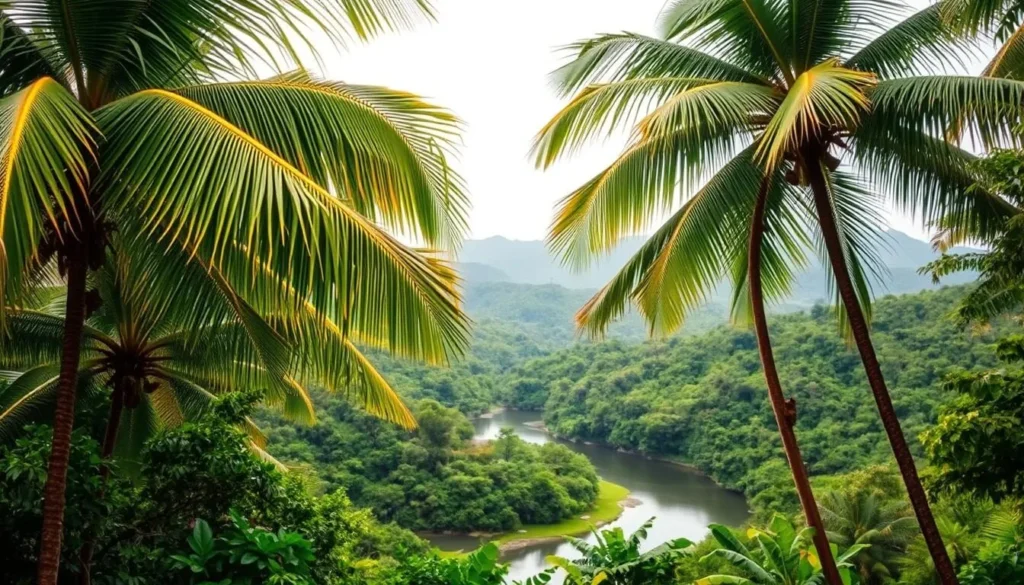
Wet Season Precipitation Levels
During the wet season, which spans from May to November, Palau experiences higher levels of precipitation. This period is characterized by frequent rain showers, although they are often brief. The wet conditions can affect the weather and visibility for activities like diving and snorkeling.
Drier Months: January to March
The months from January to March are considered the heart of Palau’s dry season, with less rainfall and clearer skies. February is typically the driest month, making it an optimal time for weather-dependent activities. The drier conditions during these months provide excellent visibility for exploring Palau’s famous diving and snorkeling sites, as well as its terrestrial attractions.
Sunshine and Cloud Cover by Month
To make the most of your visit to Palau, it’s essential to know what to expect regarding sunshine and cloud cover throughout the year. The tropical climate means that sunshine hours remain relatively consistent, but cloud cover can vary significantly from month to month.
Clearest Skies: February and March
February and March offer the clearest skies in Palau, making them ideal for outdoor activities and sightseeing. During these months, you can expect minimal cloud cover, allowing for uninterrupted sunshine and optimal conditions for photography and exploring the islands.
Overcast Periods: September to November
The period from September to November is characterized by overcast skies, typical for tropical regions during this season. Here are some key points to consider:
- Cloud cover frequently exceeds 70% of daylight hours, significantly impacting sunshine.
- This increased cloud cover coincides with the peak of the wet season, when afternoon rain showers become more frequent and sometimes intense.
- The higher humidity and cloud cover create a different photography experience, with softer light and more dramatic skies.
- Despite the overcast conditions, temperatures remain warm and tropical, consistent with Palau’s climate.
- Many photographers appreciate the diffused lighting conditions during this period for capturing lush landscapes and vibrant greens resulting from increased rain.
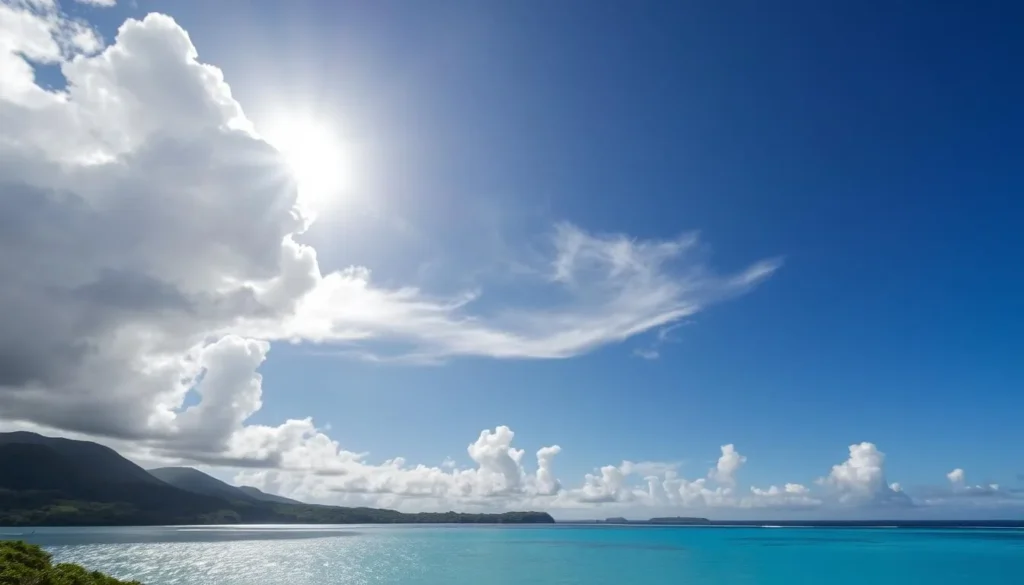
Wind Conditions and Their Seasonal Variations
As you plan your visit to Palau, it’s essential to consider the seasonal wind variations to ensure optimal conditions for your preferred activities.
Windy Season
From November to June, Palau experiences its windier months, which can impact your diving and other water activities. During this period, the increased wind can create choppy water surfaces, making it less ideal for certain activities.
Calmer Months
In contrast, the months from July to October bring calmer wind conditions, creating glassy water surfaces perfect for diving and other activities. Although this period coincides with the wet season, the tranquil seas offer a trade-off between calm waters and the likelihood of rain showers.
| Period | Wind Conditions | Ideal Activities |
|---|---|---|
| November to June | Windy | Limited water activities |
| July to October | Calm | Diving, snorkeling, kayaking |
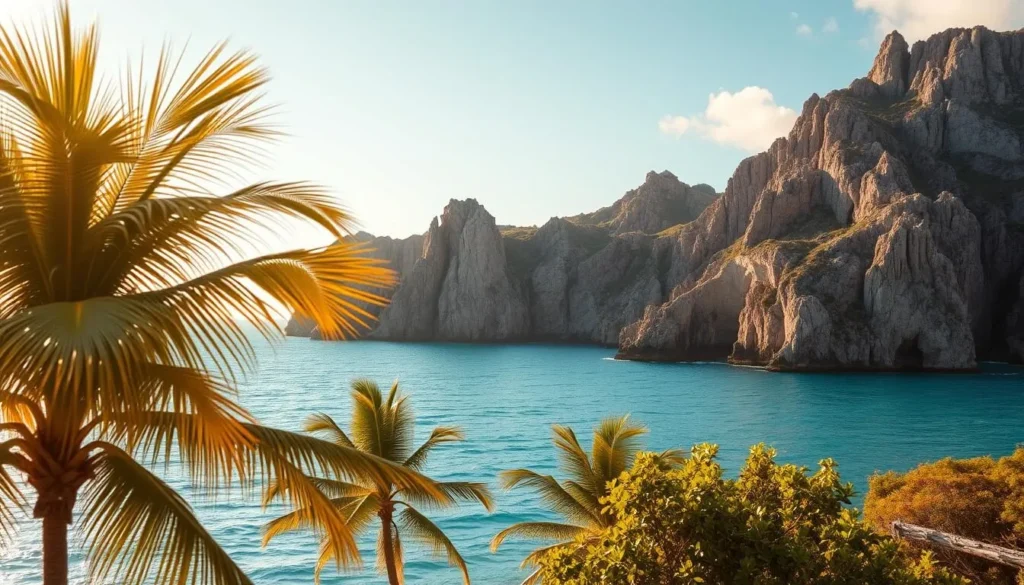
Water Temperature and Ocean Activities
Palau’s warm waters offer a paradise for ocean enthusiasts throughout the year. The consistent tropical climate ensures that the sea temperature remains pleasant, making it ideal for various water activities.
Optimal Months for Swimming and Snorkeling
The best time for swimming and snorkeling in Palau is from January to April, when the waters are calm and visibility is at its peak. During these months, you can enjoy crystal-clear waters with minimal currents, making it perfect for exploring the underwater world.
Diving Conditions Throughout the Year
Diving in Palau is a year-round activity, with each season offering unique advantages. The drier months from January to March provide the best diving visibility, often exceeding 100 feet. Even during the wetter months, the calmer wind conditions can make for smoother boat entries and exits, enhancing your diving experience.
| Month | Diving Conditions | Visibility |
|---|---|---|
| January to March | Excellent | 100+ feet |
| July to October | Good | 80-100 feet |
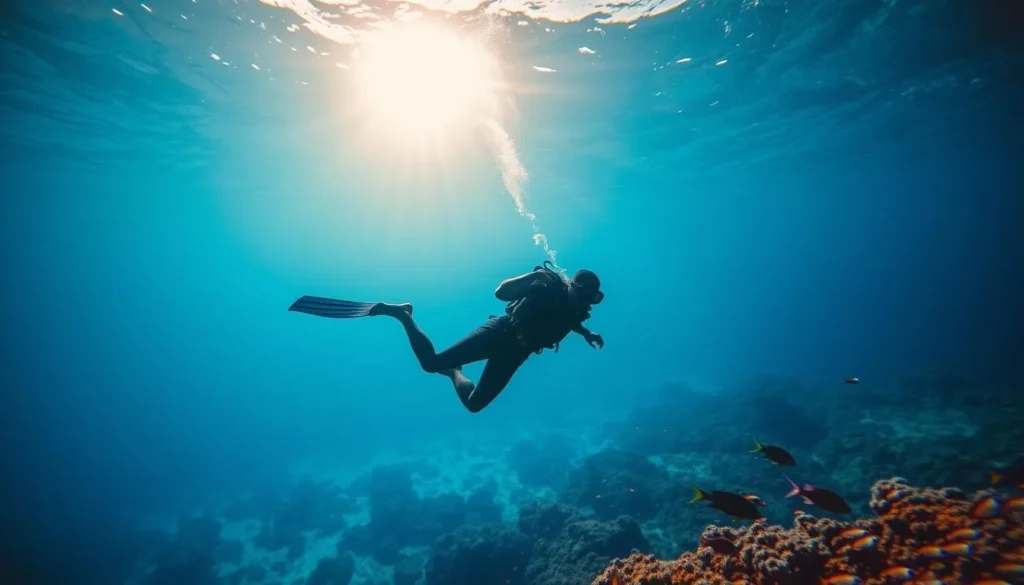
Humidity Levels and Comfort Factors
Understanding humidity levels is crucial for a comfortable trip to Palau. The tropical climate means that humidity is a significant factor throughout the year.
Managing High Humidity
Managing high humidity is essential for enjoying your time in Palau. While the humidity is generally high, the dry season offers slightly more comfortable conditions. You can stay comfortable by staying hydrated, wearing light clothing, and taking breaks in shaded or air-conditioned areas.
Beach/Pool Score for Outdoor Activities
The beach/pool score is a useful indicator of when Palau is at its best for outdoor activities. From early January to early April, the score is high, making it ideal for enjoying beaches, lagoons, and pools. February and March are particularly good, offering a perfect balance of warm temperatures, minimal rainfall, and moderate humidity.
| Month | Beach/Pool Score | Conditions |
|---|---|---|
| January | 8/10 | Clear skies, moderate humidity |
| February | 9/10 | Optimal weather, minimal rainfall |
| March | 9/10 | Warm temperatures, low rainfall |
During these months, activities like swimming, sunbathing, and beach volleyball are most enjoyable. Even with the optimal conditions, practicing sun safety with high-SPF sunscreen is recommended due to Palau’s proximity to the equator.
Planning Around Daylight Hours
As you plan your visit to Palau, consider how the daylight hours can optimize your itinerary. With around 12 hours of daylight throughout the year, you have a consistent window to plan your activities without significant adjustments.
Sunrise and Sunset Patterns
Palau’s sunrise and sunset patterns are relatively consistent, allowing you to plan your day around these natural events. Early mornings are ideal for water activities like diving and snorkeling due to calmer waters and cooler temperatures.
Maximizing Daylight for Activities
To make the most of your experience in this tropical paradise, consider the following tips when planning your trip:
- Start your day early to take advantage of the calm morning waters for activities like kayaking or paddleboarding.
- Use the midday hours (11 AM – 2 PM) for indoor activities or relaxation, avoiding the peak sun.
- The late afternoon offers softer lighting, ideal for photography and outdoor activities as temperatures cool slightly.
- Adopt a split schedule: morning activities, midday rest, and late afternoon/early evening excursions to maximize your enjoyment and energy levels.
By aligning your daily schedule with the natural rhythm of daylight in Palau, you can enhance your overall experience at this beautiful destination, making the most of your time.
Best Months for Specific Activities
Whether you’re looking to relax on the beach or explore Palau’s rich cultural heritage, the timing of your visit can greatly impact your experience.
Optimal Times for Beach Activities
The dry season, from January to April, is considered the best time for beach activities in Palau. During these months, you can enjoy calm seas and plenty of sunshine, making it ideal for swimming, snorkeling, and sunbathing. The comfortable weather conditions during this period allow for a more enjoyable experience on Palau’s beautiful beaches.
Ideal Periods for Cultural Exploration
Cultural exploration in Palau can be enjoyed year-round, but the period from January to March often offers the most reliable weather for visiting outdoor cultural sites. The drier months allow for more comfortable walking tours of historical sites and traditional meeting houses, enhancing your overall experience of Palau’s rich cultural heritage. By planning your trip during this time, you can fully immerse yourself in Palau’s history and traditions.
Weather Considerations for Island Hopping
As you plan your trip to Palau’s diverse islands, consider the impact of weather on your island-hopping itinerary. Understanding the weather patterns is crucial for a smooth and enjoyable experience.
Inter-Island Travel and Weather Impacts
When planning multi-island itineraries in tropical regions, building in buffer days is essential regardless of the season. For itineraries focusing on the outer islands, which often have more limited transportation options, the January to April period provides the best chance of adhering to planned schedules.
Planning Multi-Island Itineraries
The most reliable months for ambitious multi-travel itineraries are February and March, when you’ll encounter the fewest weather disruptions. Consider a hub-based approach during the wet season (May-November), staying on the main islands and making day trips to outlying areas when conditions permit. Working with local operators who understand the nuances of Palau’s weather patterns can enhance your travel experience. Each island in this tropical paradise offers unique landscapes and experiences, so even if weather prevents visiting every planned destination, you’ll still enjoy the remarkable diversity of the islands you do reach.
Packing Tips for Different Seasons
To ensure a smooth and enjoyable journey to Palau, it’s crucial to pack according to the season. Understanding the weather conditions during your visit will help you prepare the right clothing and gear for a comfortable trip.
Essential Items Year-Round
Regardless of the season, there are certain essentials you should always pack for a trip to Palau. Quick-dry clothing is a must due to the tropical climate and potential rain showers. Additionally, consider bringing waterproof cases or dry bags to protect your electronic equipment, such as cameras and phones, from water damage.
| Item | Reason |
|---|---|
| Quick-dry clothing | Tropical climate and potential rain |
| Waterproof cases or dry bags | Protection for electronic equipment |
Season-Specific Packing Recommendations
For visits during the windier months (November to June), consider packing a light windbreaker or wind shell to protect against wind chill during boat transfers. During the peak wet season (September to November), include a lightweight, packable rain jacket or poncho, and possibly a small travel umbrella to stay dry.
- For the dry season (December-April), focus on heat management and sun protection.
- During the wet season (May-November), pack extra changes of clothes and consider quick-dry fabrics.
Weather-Savvy Travel Tips for Palau
For a seamless trip to Palau, staying informed about the weather is key. Understanding the local climate conditions can significantly enhance your travel experience.
Monitoring Weather Forecasts
Keeping an eye on weather forecasts is crucial, especially during the wet season. Reliable sources like the Joint Typhoon Warning Center provide timely updates, helping you plan your activities and stay safe.
Dealing with Humidity Year-Round
Palau’s tropical climate means high humidity levels throughout the year. Staying hydrated and taking breaks in shaded or air-conditioned areas can help you cope with the humid conditions.
Typhoon Preparedness
Although Palau is on the edge of the typhoon belt, it’s not entirely typhoon-free. Ensure your travel insurance covers weather-related disruptions. Stay informed about typhoon risks, and know your accommodation’s emergency procedures.
| Preparation Tip | Description | Benefit |
|---|---|---|
| Monitor Forecasts | Stay updated with reliable weather forecasts | Plan activities safely |
| Manage Humidity | Stay hydrated and take breaks | Enjoy your trip comfortably |
| Typhoon Insurance | Ensure insurance covers weather disruptions | Travel with peace of mind to your desired destination |
Conclusion: Making the Most of Your Palau Visit
Palau’s unique tropical experience is greatly enhanced by weather-savvy travel planning. To make the most of your trip, aligning your travel dates with your priority activities is crucial.
For an optimal experience, consider visiting between February and March, when clear skies and calm seas provide ideal conditions for both water and land activities. Even during the wet season, Palau’s natural beauty shines through, offering breathtaking landscapes and warm hospitality that makes this destination special.
Building flexibility into your itinerary allows you to adapt to changing weather conditions, maximizing enjoyable experiences regardless of when you visit the islands. With travel planning focused on weather, your Palau adventure will be memorable for all the right reasons, whether you’re drawn by world-class diving, pristine beaches, or rich cultural experience.
The above is subject to change.
Check back often to TRAVEL.COM for the latest travel tips and deals.
